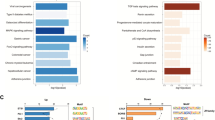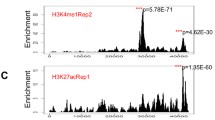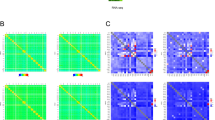Abstract
Genomic experiments produce large sets of data, many of which are publicly available. Investigating these datasets using bioinformatics data mining techniques may reveal novel biological knowledge. We developed a bioinformatics pipeline to investigate Chip-seq DNA binding proteins datasets for HepG2 liver cancer cell line downloaded from ENCODE project. Of 276 datasets, 175 passed our proposed quantity control testing. A pair-wise DNA co-location analysis tool developed by us revealed a cluster of 19 proteins significantly collocating on DNA binding regions. The results were confirmed by tools from other labs. Narrowing down our bioinformatics analysis showed a strong enrichment of DNA-binding protein SIN3A to activator (H3K79me2) and repressor (H3K27me3) indicating SIN3A plays has an important regulatory role in vital liver functions. Whether increased enrichment varies in liver infection we compared histone modification between HepG2 and HepG2.2.15 cells (HepG2 derived hepatitis B virus (HBV) expressing stable cells) and observed an increase SIN3A enrichment in promoter regions (H3K4me3) confirming a known biological phenotype. The mechanistic role of SIN3A protein in case of liver injury or insult during liver infection warrants further dry and wet lab investigations.
Access this chapter
Tax calculation will be finalised at checkout
Purchases are for personal use only
Similar content being viewed by others
References
Andrews, S.: Babraham bioinformatics-fastqc a quality control tool for high throughput sequence data (2010). https://www.bioinformatics.babraham.ac.uk/projects/fastqc/
Chandran, A.K.N., et al.: A web-based tool for the prediction of rice transcription factor function. Database 2019, 1–12 (2019)
Dunham, I., et al.: An integrated encyclopedia of DNA elements in the human genome (2012)
Favorov, A., et al.: Exploring massive, genome scale datasets with the genometricorr package. PLoS Comput. Biol. 8(5), e1002529 (2012)
Fekry, B., et al.: Incompatibility of the circadian protein bmal1 and hnf4\(\alpha \) in hepatocellular carcinoma. Nat. Commun. 9(1), 1–17 (2018)
Flecken, T., et al.: Mapping the heterogeneity of histone modifications on hepatitis B virus DNA using liver needle biopsies obtained from chronically infected patients. J. Virol. 93(9), e02036 (2019)
Jammula, S., Pasini, D.: Epimine, a computational program for mining epigenomic data. Epigenetics Chromatin 9(1), 42 (2016)
Jing, F., Zhang, S., Cao, Z., Zhang, S.: An integrative framework for combining sequence and epigenomic data to predict transcription factor binding sites using deep learning. IEEE/ACM Trans. Comput. Biol. Bioinf. (2019)
Khushi, M.: Benchmarking database performance for genomic data. J. Cell. Biochem. 116(6), 877–883 (2015)
Khushi, M., Clarke, C.L., Graham, J.D.: Bioinformatic analysis of cis-regulatory interactions between progesterone and estrogen receptors in breast cancer. PeerJ 2, e654 (2014)
Khushi, M., Liddle, C., Clarke, C.L., Graham, J.D.: Binding sites analyser (bisa): software for genomic binding sites archiving and overlap analysis. PloS one 9(2), e87301 (2014)
Landt, S.G., et al.: Chip-seq guidelines and practices of the ENCODE and modENCODE consortia. Genome Res. 22(9), 1813–1831 (2012)
Langmead, B., Trapnell, C., Pop, M., Salzberg, S.L.: Ultrafast and memory-efficient alignment of short DNA sequences to the human genome. Genome Biol. 10(3), R25 (2009)
Li, Q., Brown, J.B., Huang, H., Bickel, P.J., et al.: Measuring reproducibility of high-throughput experiments. Ann. Appl. Stat. 5(3), 1752–1779 (2011)
López-Terrada, D., Cheung, S.W., Finegold, M.J., Knowles, B.B.: Hep g2 is a hepatoblastoma-derived cell line. Human Pathol. 40(10), 1512 (2009)
Martin, M.: Cutadapt removes adapter sequences from high-throughput sequencing reads. EMBnet. J. 17(1), 10–12 (2011)
Quinlan, A.R., Hall, I.M.: Bedtools: a flexible suite of utilities for comparing genomic features. Bioinformatics 26(6), 841–842 (2010)
Schmidt, F., Kern, F., Ebert, P., Baumgarten, N., Schulz, M.H.: Tepic 2-an extended framework for transcription factor binding prediction and integrative epigenomic analysis. Bioinformatics 35(9), 1608–1609 (2019)
Shibata, T., Aburatani, H.: Exploration of liver cancer genomes. Nat. Rev. Gastroenterol. Hepatol. 11(6), 340 (2014)
Tropberger, P., Mercier, A., Robinson, M., Zhong, W., Ganem, D.E., Holdorf, M.: Mapping of histone modifications in episomal HBV cccDNA uncovers an unusual chromatin organization amenable to epigenetic manipulation. Proc. Natl. Acad. Sci. 112(42), E5715–E5724 (2015)
Vivekanandan, P., Daniel, H.D.J., Kannangai, R., Martinez-Murillo, F., Torbenson, M.: Hepatitis B virus replication induces methylation of both host and viral DNA. J. Virol. 84(9), 4321–4329 (2010)
Wang, W., et al.: Analyzing the surface structure of the binding domain on DNA and RNA binding proteins. IEEE Access 7, 30042–30049 (2019)
Wei, H.: Construction of a hierarchical gene regulatory network centered around a transcription factor. Briefings Bioinfo. 20(3), 1021–1031 (2019)
Wong, M.C., et al.: The changing epidemiology of liver diseases in the Asia-pacific region. Nat. Rev. Gastroenterol. Hepatol. 16(1), 57–73 (2019)
Zhang, Y., et al.: Model-based analysis of chip-seq (macs). Genome Biol. 9(9), 1–9 (2008)
Zheng, X., Zhong, S.: From structure to function, how bioinformatics help to reveal functions of our genomes (2017)
Author information
Authors and Affiliations
Corresponding author
Editor information
Editors and Affiliations
Rights and permissions
Copyright information
© 2020 Springer Nature Switzerland AG
About this paper
Cite this paper
Khushi, M., Naseem, U., Du, J., Khan, A., Poon, S.K. (2020). Data Mining ENCODE Data Predicts a Significant Role of SINA3 in Human Liver Cancer. In: Yang, H., Pasupa, K., Leung, A.CS., Kwok, J.T., Chan, J.H., King, I. (eds) Neural Information Processing. ICONIP 2020. Lecture Notes in Computer Science(), vol 12534. Springer, Cham. https://doi.org/10.1007/978-3-030-63836-8_2
Download citation
DOI: https://doi.org/10.1007/978-3-030-63836-8_2
Published:
Publisher Name: Springer, Cham
Print ISBN: 978-3-030-63835-1
Online ISBN: 978-3-030-63836-8
eBook Packages: Computer ScienceComputer Science (R0)




